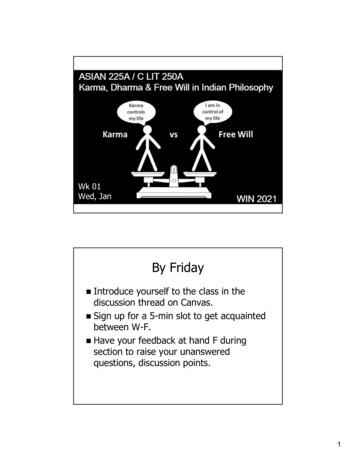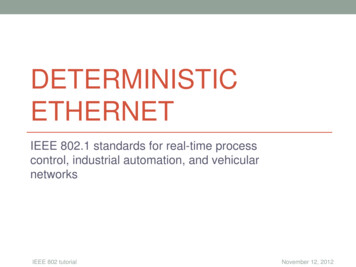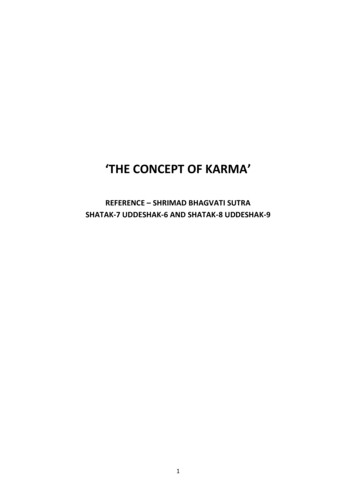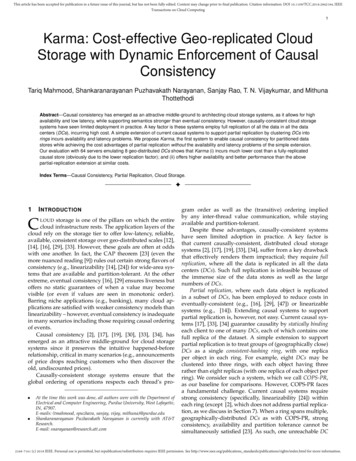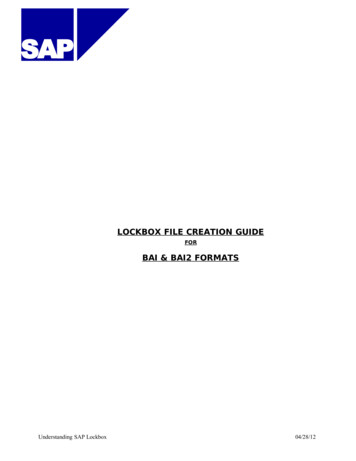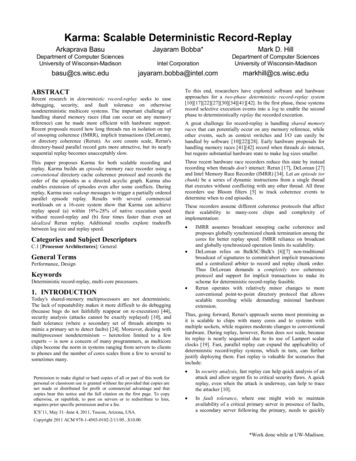
Transcription
Karma: Scalable Deterministic Record-ReplayJayaram Bobba*Mark D. HillDepartment of Computer SciencesUniversity of Wisconsin-MadisonArkaprava BasuIntel CorporationDepartment of Computer SciencesUniversity of el.commarkhill@cs.wisc.eduABSTRACTRecent research in deterministic record-replay seeks to easedebugging, security, and fault tolerance on otherwisenondeterministic multicore systems. The important challenge ofhandling shared memory races (that can occur on any memoryreference) can be made more efficient with hardware support.Recent proposals record how long threads run in isolation on topof snooping coherence (IMRR), implicit transactions (DeLorean),or directory coherence (Rerun). As core counts scale, Rerun'sdirectory-based parallel record gets more attractive, but its nearlysequential replay becomes unacceptably slow.This paper proposes Karma for both scalable recording andreplay. Karma builds an episodic memory race recorder using aconventional directory cache coherence protocol and records theorder of the episodes as a directed acyclic graph. Karma alsoenables extension of episodes even after some conflicts. Duringreplay, Karma uses wakeup messages to trigger a partially orderedparallel episode replay. Results with several commercialworkloads on a 16-core system show that Karma can achievereplay speed (a) within 19%-28% of native execution speedwithout record-replay and (b) four times faster than even anidealized Rerun replay. Additional results explore tradeoffsbetween log size and replay speed.To this end, researchers have explored software and hardwareapproaches for a two-phase deterministic record-replay system[10][17][22][27][30][34][41][42]. In the first phase, these systemsrecord selective execution events into a log to enable the secondphase to deterministically replay the recorded execution.A great challenge for record-replay is handling shared memoryraces that can potentially occur on any memory reference, whileother events, such as context switches and I/O can easily behandled by software [10][22][28]. Early hardware proposals forhandling memory races [41][42] record when threads do interact,but require substantial hardware state to make log sizes smaller.Three recent hardware race recorders reduce this state by insteadrecording when threads don't interact: Rerun [17], DeLorean [27]and Intel Memory Race Recorder (IMRR) [34]. Let an episode (orchunk) be a series of dynamic instructions from a single threadthat executes without conflicting with any other thread. All threerecorders use Bloom filters [5] to track coherence events todetermine when to end episodes.These recorders assume different coherence protocols that affecttheir scalability to many-core chips and complexity ofimplementation: Categories and Subject DescriptorsC.1 [Processor Architectures]: GeneralGeneral Terms Performance, DesignKeywordsDeterministic record-replay, multi-core processors.1. INTRODUCTIONToday's shared-memory multiprocessors are not deterministic.The lack of repeatability makes it more difficult to do debugging(because bugs do not faithfully reappear on re-execution) [44],security analysis (attacks cannot be exactly replayed) [10], andfault tolerance (where a secondary set of threads attempts tomimic a primary set to detect faults) [24]. Moreover, dealing withmultiprocessor nondeterminism -- heretofore limited to a fewexperts -- is now a concern of many programmers, as multicorechips become the norm in systems ranging from servers to clientsto phones and the number of cores scales from a few to several tosometimes many.Permission to make digital or hard copies of all or part of this work forpersonal or classroom use is granted without fee provided that copies arenot made or distributed for profit or commercial advantage and thatcopies bear this notice and the full citation on the first page. To copyotherwise, or republish, to post on servers or to redistribute to lists,requires prior specific permission and/or a fee.ICS’11, May 31–June 4, 2011, Tuscon, Arizona, USA. IMRR assumes broadcast snooping cache coherence andproposes globally synchronized chunk termination among thecores for better replay speed. IMRR reliance on broadcastand globally synchronized operation limits its scalability.DeLorean relies on BulkSC/Bulk's [6][7] non-traditionalbroadcast of signatures to commit/abort implicit transactionsand a centralized arbiter to record and replay chunk order.Thus DeLorean demands a completely new coherenceprotocol and support for implicit transactions to make itsscheme for deterministic record-replay feasible.Rerun operates with relatively minor changes to moreconventional point-to-point directory protocol that allowsscalable recording while demanding minimal hardwareextension.Thus, going forward, Rerun's approach seems most promising asit is scalable to chips with many cores and to systems withmultiple sockets, while requires moderate changes to conventionalhardware. During replay, however, Rerun does not scale, becauseits replay is nearly sequential due to its use of Lamport scalarclocks [19]. Fast, parallel replay can expand the applicability ofdeterministic record/replay systems, which in turn, can furtherjustify deploying them. Fast replay is valuable for scenarios thatinclude: In security analysis, fast replay can help quick analysis of anattack and allow urgent fix to critical security flaws. A quickreplay, even when the attack is underway, can help to tracethe attacker [10]. In fault tolerance, where one might wish to maintainavailability of a critical primary server in presence of faults,a secondary server following the primary, needs to quicklyCopyright 2011 ACM 978-1-4503-0102-2/11/05. 10.00.*Work done while at UW-Madison.
and Stoica [2] seek only to replicate a bug, not an exact replay.Lee et al. [23] seeks to log minimal information but uses onlinereplay on spare cores to validate whether logged information issufficient to guarantee output deterministic replay.Ci: Core iEij: Core i’s episode jREFS: Dynamic memory reference countTS: timestamp(dashed arrow): actual memory conflict(shaded box): per episode logFigure 1. Rerun's Recording and "idealized" replay.replay primary's execution to provide hot backup [24]. For classic use of debugging, deterministic record/replay'sutility will decline if scaling to 16, 32 or more cores, requiresa sequential replay that is at least 16X, 32X or more slower.Replaying for small intervals of time may be acceptable, butthe situation quickly worsens if replay for longer intervalsand/or large number of cores are needed.We believe that the need for scalable and fast Deterministicrecord-replay assumes further importance with respect tosupercomputing where hundreds of cores/nodes interact duringcomputation.This paper proposes Karma for both scalable recording andreplay, that minimally extends conventional directory coherenceprotocol. Karma's proposed novel episodic memory race recorderreplayer records the order of episodes as a directed acyclic graph(DAG). Karma also extends lengths of episodes that conflictduring recording by ensuring that they do not conflict duringreplay. During Karma's replay, special wakeup messages (likecoherence acknowledgment messages) trigger parallel replay ofindependent episodes. We also show how to extend Karma fromsequential consistency to Total Store Order (TSO), sufficient toimplement the x86 memory model.We evaluate Karma on a 16-core system and find that: (1) Karmacan achieve replay speed within 19-28% of native execution withno-record-replay and about 4 times faster than even idealizedRerun's replay. (2) Karma's log size is similar to Rerun's, but (3)can be made smaller for uses that can tolerate slower replay.2. Related Work and Rerun Review2.1 Related WorkClassic all-software solutions to deterministic multiprocessorreplay exist [11][22], but results show that they do not performwell on workloads that interact frequently. Three recent,promising approaches seek to reduce recording overhead, butconsequently make replay more difficult. Park et al. [33] recordpartial information and retry replay until successful, while AltekarArchitecture researchers have focused on solutions that usehardware, at least for memory race detection. Bacon andGoldstein [3] recorded all snooping coherence transactions, whichproduced a serial and voluminous log. Xu et al.'s Flight DataRecorder (FDR) [41][42] created a distributed log of a subset ofmemory races, not implied by other races, but required substantialstate with each core. Bugnet [31] shows how to enable recordreplay by recording input values rather than memory race order.Strata [30] uses global strata to reduce this state, but does notscale well to many cores [17]. ReEnact [35] allowed deterministicreproduction of a recent buggy execution with Thread LevelSpeculation (TLS) support. As previously discussed, DeLorean,Rerun, and IMMR largely eliminate FDR's filtering state byfocusing on when cores operate independently. More recently,Timetraveller [39] improved upon Rerun to reduce its log sizefurther by delaying ending of episodes in Rerun. Herein wepropose Karma to improve Rerun's replay speed, and we expectthat Karma's improvements will apply to Timetraveller as well.Importantly, Capo [28] discusses how to virtualize hardwaredeterministic replayers-including FDR, Rerun, and DeLorean-sothat different parts of a machine can be in different modes:recorder, replay, or none. Fortunately, Karma, can also bevirtualized with Capo.Finally, there have been several recent efforts on obtainingdeterministic execution, wherein a multithreaded program with afixed input always executes the same way [4][9][32]. Somewhatrelated is Yu et al.'s work [44] to constrain production softwareruns to the set of interleaving observed during testing. Whilepromising, these approaches are not (yet) generally adopted.2.2 Rerun ReviewWe review Rerun here to better enable Section 3 to showhow Karma supersedes it, even as both modestly extendconventional directory cache coherence protocols.Record: Rerun dynamically breaks each core's execution intoepisodes during which a core does not interact with other cores.Rerun ends an episode when memory references of an episodeconflict with a concurrent episode on another core. It can endepisodes early, e.g., due to false conflicts, L1 cache evictions, orcontext switches. Rerun orders episodes with the timestampsbased on a Lamport scalar clock [19]. Rerun's global log is adistributed collection of per-core logs. Each per-core log capturesa core's sequence of episodes with each episode's size in dynamicmemory references (REFS) and Lamport scalar clock basedtimestamp (TS). Figure 1(a) illustrates a Rerun recording, afterthreads at each core executed for some time initially. In Figure1(a), when during episode E10, core C1 tries to read memoryblock A, a coherence intervention message is sent to core C0,which had written the same address as part of episode E00. Thisprompts C0 to end episode E00, as it detects a conflict andattaches its own timestamp in the coherence reply (dotted directededge in Figure 1(a)). After receiving the coherence reply, core C1adjusts the timestamp of episode E10 accordingly to capture thefact that E10 must be ordered after E00 during replay. Theproposed Rerun implementation uses per-core read and writeBloom filters to detect when to end episodes and piggybacks
timestamps on coherence response messages to capture the causalordering among the episodes.Replay: Rerun advocates software-based fully sequential replayof episodes in increasing order of their timestamps. In theory,however, scalar timestamps allow some parallelism, whereepisodes with the same timestamp can be replayed concurrently.We illustrate this idealized Rerun replay (non-sequential) inFigure 1(b). On one hand, it allows episodes E21 and E31 to bereplayed concurrently. On the other hand, Lamport scalar clocksunnecessarily orders many independent episodes (e.g., E20 withepisodes from cores C0 and C1).3. Insights: Replaying Episodes in ParallelAs multi-threaded programs scale to more cores, replay must beparallelized otherwise it can become arbitrarily slow, limiting theutility of record-replay for online uses (e.g., fault tolerance,security analysis) and eventually debugging. To this end, thissection introduces insights into Karma's parallel replay with both(a) ordering episodes with DAG and (b) extending episodes.While we present how Karma orders the execution in the cores,Karma-like FDR, Rerun, and DeLorean-can be virtualized byCapo [28].3.1 Key Idea 1: Using Directed Acyclic Graphto Order Episodes During Replay. The first key idea behind Karma is simple: Use a directedacyclic graph (DAG) rather than scalar timestamps to partiallyorder episodes during replay. DAGs are well known to allowmuch greater parallelism than scalar timestamps and have beenused in an offline analysis of replay speed potentials ofdeterministic recording schemes [34]. For ease of exposition, wefirst show the value of using a DAG by pretending that Karma'srecording breaks the execution into exact same episodes as Rerundid in Figure 1, and then, in Section 3.2, present a secondinnovation that allows Karma to have longer episodes than Rerunpermits.To this end, Figure 2(a) illustrates how Karma can recordmemory dependencies among cores by triggering episodeformation with DAG edges to successor episode(s). Karma'sdistributed log resembles Rerun's log with timestamps replaced byDAG edges (represented as PRED/SUCC sets explained below).Figure 2(b) illustrates the parallelism of Karma's replaywherein successor episodes execute after their predecessorswithout other artificial ordering constraints. Importantly, thisenables a parallel replay that is much faster than even Rerun'sidealized replay. For example, while Rerun ordered episode E20with independent episodes of cores C0 and C1 (Figure 1(b)),Karma's replay leaves episode E20 unordered with respect to theepisodes of cores C0 and C1 (Figure 2(b)), facilitating morereplay parallelism.While the idea of using a DAG is simple, it is less simple todetermine how to represent DAG edges to successor episode(s).For fastest replay, the DAG edge representation should facilitatean episode waking up the successor episode(s) quickly. Moreover,for low recording overhead, it should be fast to create duringrecording and compact to log. Using integer episode identifiers, asin a software representation of DAG edges, is a poorrepresentation, as we see no way for replay to avoid indirectingthrough memory to determine the successor(s). Using theseepisode identifiers would also have severe negative impact on logsize.See KEY of Figure 1 and followingKEY:PRED: predecessor setSUCC: successor set(solid arrow): wakeup messageFigure 2. Karma's DAG-based Record and Replay withRerun's EpisodeAs discussed in more details in Section 4.3, to efficiently recordthe DAG edges, Karma represents DAG edges with predecessor(PRED) and successor (SUCC) sets that name the cores of thepredecessor and successor episodes respectively. Duringrecording, these sets are populated from coherence traffic and thenlogged. During replay, a core awaits a wakeup message from eachpredecessor before beginning an episode and sends a wakeupmessage to each successor after completing an episode.3.2 Key Idea 2: Extending Rerun’s EpisodeThe second key idea behind Karma is subtle: Concurrent episodesmust not conflict during replay, but may conflict duringrecording. In contrast, Rerun, DeLorean and IMRR always endepisodes when they conflict during recording. For example inFigure 1(a) for Rerun, core C0 ends episode E00 when it givesblock A to core C1 for episode E10. In Figure 2(a), we showKarma behaving similarly, but this is not necessary. Morerecently, Timetraveller [39] which improves upon Rerun's log sizeuses post-dating of scalar timestamps to also allow growingepisodes even after some conflicts.In contrast, as shown in Figure 3(a), Karma continues recording inepisode E00 even as it conflicts with episode E10, as long as itorders E00 before E10 in the log. During replay, conflictingepisodes E00 and E10 will not be concurrent, because the logentries will ensure that the end of E00 precedes the beginning ofE10. In similar fashion, core C1 can cover its execution of 41references with one episode E10 (Figure 3(a)), rather than twoepisodes E10 and E11 (Figure 2(a)). Beside the restrictiondiscussed below, a core is not required to end a episode wheneither it (a) provides a block to another core or (b) obtains a blockfrom another core. On one hand, this optimization seems too goodto be true. Perhaps the authors of Rerun and DeLorean missed it,because they appear to be inspired by transactional memorysystems [15][21] that usually abort when concurrent transactionsconflict in an execution (as there is no distinction betweenrecording and replay). Fortunately in Dependence Aware TM,
Karma can extend episodes to reducelog sizes.Figure 3. Karma's Record and Replay with ExtendedEpisodesRamadan et al. [36] showed that conflicting concurrenttransactions can all commit, provided that they are properlyordered. For example, they allow core C0's transaction T to pass avalue to core C1's concurrent transaction U (and both commit) aslong as T is ordered before U. Karma exploits a similar idea forepisodes. Both are inspired by the greater freedom of conflictserializability over two-phase locking [12] and value forwardingamong "episodes" in some thread-level-speculation systems (e.g.,[13][37]).On the other hand, full exploitation of the optimization is notpossible. As depicted in Figure 3(a), a problem occurs when thecore C0 later attempts to order E00 after core C1's episode E10because of conflict in block E (memory reference 4 of core C0),but E00 was previously ordered before E10 due to block A (orconversely a core seeks to order an episode before another episodepreviously ordered after). Karma cannot do this without adding acycle to the DAG, which is not allowed, as it would makeordering replay impossible. Instead, Karma always ends episodeE00, begins episode E01 (with memory reference 4 as its firstreference), and orders E01 after E10 of core C1.Karma detects the possibility of cycle formation in the recordedDAG using Lamport scalar clock based timestamps [19] (butnever logs them). Karma ends an episode when it receives atimestamp greater than the timestamp of the current episode. Thisensures that the order of episodes is acyclic and can be replayedproperly. Since Karma does not log timestamps, they cannotserialize replay and the sole purpose of this timestamp is todynamically detect possibility of cycles while recording.Finally, Karma enables a tradeoff between log size and replayparallelism, similar to one found in few other record-replaysystems [27][42]. Growing longer episodes has two effects. First,larger episodes mean fewer episodes to cover an execution. Thismakes log size smaller. Second, longer episodes make replay lessparallel and slower. This is because during replay the end of apredecessor episode happens before the beginning of a successorepisode. For example, earlier we saw that Karma could cover coreC1's execution of 41 memory references with one episode (Figure3(a)) rather than two (E10 and E11 in Figure 2(a)). In Figure 3(b),we however observe that during replay, this means that episodeCore16 core, in-order, 3 GHzL1 CachesSplit I&D, Private, 4-way set-associative,write-back, 64B lines, LRU, 3cycles hitL2 CachesUnified, Shared, Inclusive, 16M 8-way setassociative, write-back, 16 banks, LRUreplacement, 21 cycle hitDirectoryFull Bit vector at L2Memory4GB DRAM , 300 cycle accessCoherenceMESI Directory, Silent C)extension to TSO in Section 4.7)(withTable 1. Base system ConfigurationE01 can only start execution after the merged bigger episode E10completes its execution. For this reason, as we will find in Section6, there is value in bounding the maximum episode size to balancelog size and replay parallelism.3.3 A Sketch of Karma OperationThis section sketches Karma's basic operation for recordingand replay, but leaves details for Section 4.Record Sketch: During recording, Karma grows episodesand passes timestamps on coherence response messages. Eachcore grows its episode until it receives a timestamp greater than itscurrent timestamp (or a maximum size is reached, etc.). Thisindicates possibility of cycle in the DAG. At this point, it ends itsepisode, saves the corresponding predecessor/successor set forlogging, and begins a new episode. When responding with atimestamp, a core sends its current timestamp for a block thatmatches in its read/write filter or its previous timestampotherwise. For implementation reasons discussed later, a Karmacore keeps the timestamp and predecessor/successor sets for bothits immediately previous and current episodes. When an episodeends at a core, it logs the memory reference count, predecessorand successor set of the immediately previous episode, but neverlogs the timestamp.Replay Sketch: During replay, a Karma core repeats foursteps. (1) Read the predecessor/successor (PRED/SUCC) sets andreference count REFS for its next episode. (2) Wait for wake-upmessages from each core in the episode's predecessor set. (3)Execute instructions for REFS memory references. (4) Send awakeup message to each core in the successor set.Online Replay? While we present the record and replayphases as separate, applications like fault tolerance may wish to"pipe" the log from recording to a concurrent replay. Karma'sfaster parallel replay makes this online replay more promising, butwe leave detailed design issues to future work.4. Implementing KarmaWhile the previous section presented the ideas behindKarma, this section presents a concrete hardware implementationand addresses additional issues.4.1 Example Base SystemWe assume a base system as illustrated in Figure 4 with parametervalues from Table 1. It is a multicore chip with private writebackL1 caches, shared multibanked L2 and a MESI directory protocol.
Figure 4. Base system configuration with Karma's state percore4.2 Karma HardwareAs Figure 4 depicts, Karma adds eight registers (148 bytes) toeach core: 128-byte address filter (FLT) (combining Rerun'sread/write filters), 4-byte reference count (REFS), and for both theprevious and current episodes, there are predecessor sets (PRED0and PRED1), successor sets (SUCC0 and SUCC1) and 4-bytetimestamps (TS0 and TS1). For 16 cores, all sets can berepresented with 2-byte bit vectors, while more scalablerepresentations are possible as many episodes have one or twopredecessor or successor.Karma assumes L2 cache blocks include a directory that trackswhere a block is cached in the L1s, L1 cache shared replacementsare silent, and L1 writebacks continue to remember the previousowner. Section 4.6 will discuss additional issues due to L1 and L2caches being finite. Karma passes timestamps on coherenceresponse messages. Karma also adds a single bit calledpreviouslyOrdered in coherence response message, to beexplained in next section. For supporting replay, Karma addswakeup messages whose only payload is a source core identifier.4.3 Predecessor and Successor SetsThis subsection discusses some subtle issues for how and whyKarma represents DAG edges between episodes as predecessorand successor sets between cores. We implement each set with a2-byte bit vector, but larger systems can use other encodings sincemost of these sets have just one or a few elements.that this message does not represent an edge, as depicted in Figure5(a) and (b). This edge is redundant because of the previous edgeto this core. On receiving a message that would be the secondincoming edge from another core, we end the receiving core'sepisode, start a new episode, and add the edge to the otherwiseempty new predecessor set (Figure 5(c)). This works, since corescan always end episodes early. On receiving a request messagefrom a core already ordered after this core's current episode, thiscore responds with the previouslyOrdered bit set so that thismessage is also not a DAG edge, as depicted in Figure 5(d). Thisaction is correct because the missing edge is implied bytransitivity [41].Karma's approach for representing DAG edges leads to aconvenient invariant during replay (Section 4.5): when a corereceives a wakeup message from core req, the message pertains tothe receiving core's next episode whose predecessor set includescore req. This allows the wakeup message to physically name acore and yet have the edge be applied to a specific episode as inFigure 3(b).4.4 Karma RecordingAs depicted in Figure 6, the key to Karma recording is whatactions Karma takes when a core/L1 sends a data response oracknowledgement (left side) and receives data or anacknowledgement in response to a coherence request it has made(right side). The top of Figure 6 repeats the Karma state fromFigure 4.During recording, each core sometimes sends a coherence reply(data and acknowledgement) in response to coherence requestfrom another core req (Figure 6 (a)). The core first tests whethercore req is already an element of SUCC1. If it is, the outgoingmessage's previouslyOrdered bit is set, so that the message doesnot create an edge in the DAG (Section 4.3) and no other actionsare needed.Otherwise, the core examines whether its address filter containsthe message address (or a false positive). If so, then the coreassociates the outgoing edge with its current episode. It sets themessage's timestamp to TS1 and previouslyOrdered bit to false. Itthen adds core req to SUCC1. If the filter does not match, the coreassociates the message with its previous episode and takescorresponding actions using TS0 and SUCC0. This is correct,because if a block is not touched by the current episode it wastouched no later than the previous episode at that core.During recording, a core executes instructions, which sometimesgenerate cache misses and coherence requests. Upon receiving acoherence response message (data or acknowledgement) fromcore src, a core may or may not take any actions for recording(Figure 6(b)). In particular, if the incoming message'spreviouslyOrdered bit is set, no action is needed, because themessage comes from a core whose current or previous episodewas already ordered with respect to this core's earlier or currentepisode.Figure 5. Subtle implementation issues regarding Predecessorand Successor SetsSince predecessor and successor sets can only record a single edgefrom/to each other core, we take special care to avoid recording asecond edge between the same two cores (Figure 5). Whensending a message that would constitute a second outgoing edgefrom an episode to the same other core, we set thepreviouslyOrdered bit in the coherence reply message to indicateIf episode ordering is required, the incoming message may causethe current episode to end for two reasons. First, the episode endsif SUCC1 is not empty and the message's timestamp is greaterthan the current episode's timestamp. This is done to preventcycles in the DAG. Second, the episode ends on incomingmessage from core src that is already in the current episode'sPRED1.
Figure 6. Karma's Recording Algorithm (at each core)To end an episode, a core logs the previous episode's memoryreference count and the predecessor/successor sets, copies thecurrent episode's information to the previous one's, and theninitializes the new current episode's values. In particular, thetimestamp update follows Lamport scalar clock rules, the filter iscleared, the successor set made empty, and predecessor set madeto contain only the message source (core src). The timestamp isnot logged and thus has no role in replay.4.5 Karma ReplayDuring replay, a Karma core repeats four steps, as depicted inFigure 7.(1) When a core is ready to start a new episode, it reads thepredecessor/successor (PRED1/SUCC1) sets and reference countREFS1 for the next episode from its per-core log. These valuesare stored in the same special registers as used in recording.Replay on this core is complete when its log is empty.(2) The core waits for wakeup messages from each core in theepisode's predecessor set PRED1. When the core has received amessage for all cores originally in PRED1, it moves to the nextstep.(3) The core executes instructions of the episode, decrementingREFS1 on each dynamic memory references, and stops executionwhen the episode REFS1 is zero and the episode is complete.(4) The core sends a wakeup message to each core in its successorset SUCC1. When complete, the core goes back to step (1).Karma's replay algorithm counts committed memory references,but never micro-architectural events, such as cache misses. Thus,Karma replay does not require the same caches or cache state aswas present during Karma recordingThe description above acts as if the wakeup messages arriveonly during step (2), whereas they can actually arrive at any time.We implement a simple replayer that just buffers early messages.A more complex replayer could "pipeline" episodes by reading thenext log entry early and gathering wakeup messages for the nextepisode while the current episode is still executing.More subtly, wakeup messages for future episodes can arriveearlier than ones needed for the next episode(s), theoreticallyfilling up any fixed sized message buffer. Fortunately, since theonly information that must be remembered about a wakeupmessage is its source core identifier, a core can remember up to 8wakeup messages per core (128 total) using a three-bit counter foreach of 16 cores (6 bytes total). Moreover, these buffer counts canbe made unbounded using known "limitless" techniques [8] thatmaintain rare overflow counts in software.4.6 Effect of Finite CachesHeretofore we assumed infinite L1 and L2 caches, but realsystems have finite caches. Here
replay. During Karma's replay, special wakeup messages (like coherence acknowledgment messages) trigger parallel replay of independent episodes. We also show how to extend Karma from sequential consistency to Total Store Order (TSO), sufficient to implement the x86 memory model. We evaluate Karma on a


